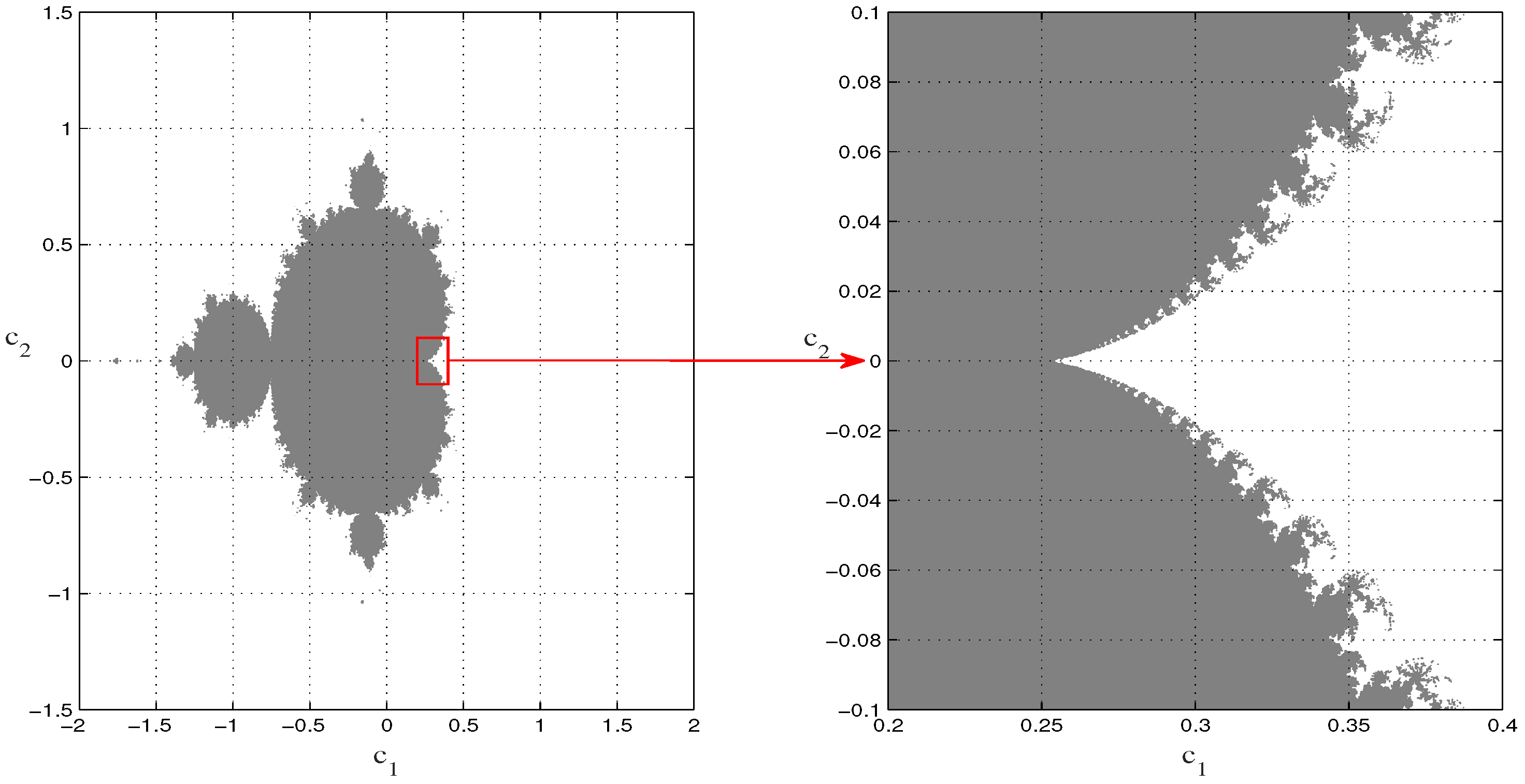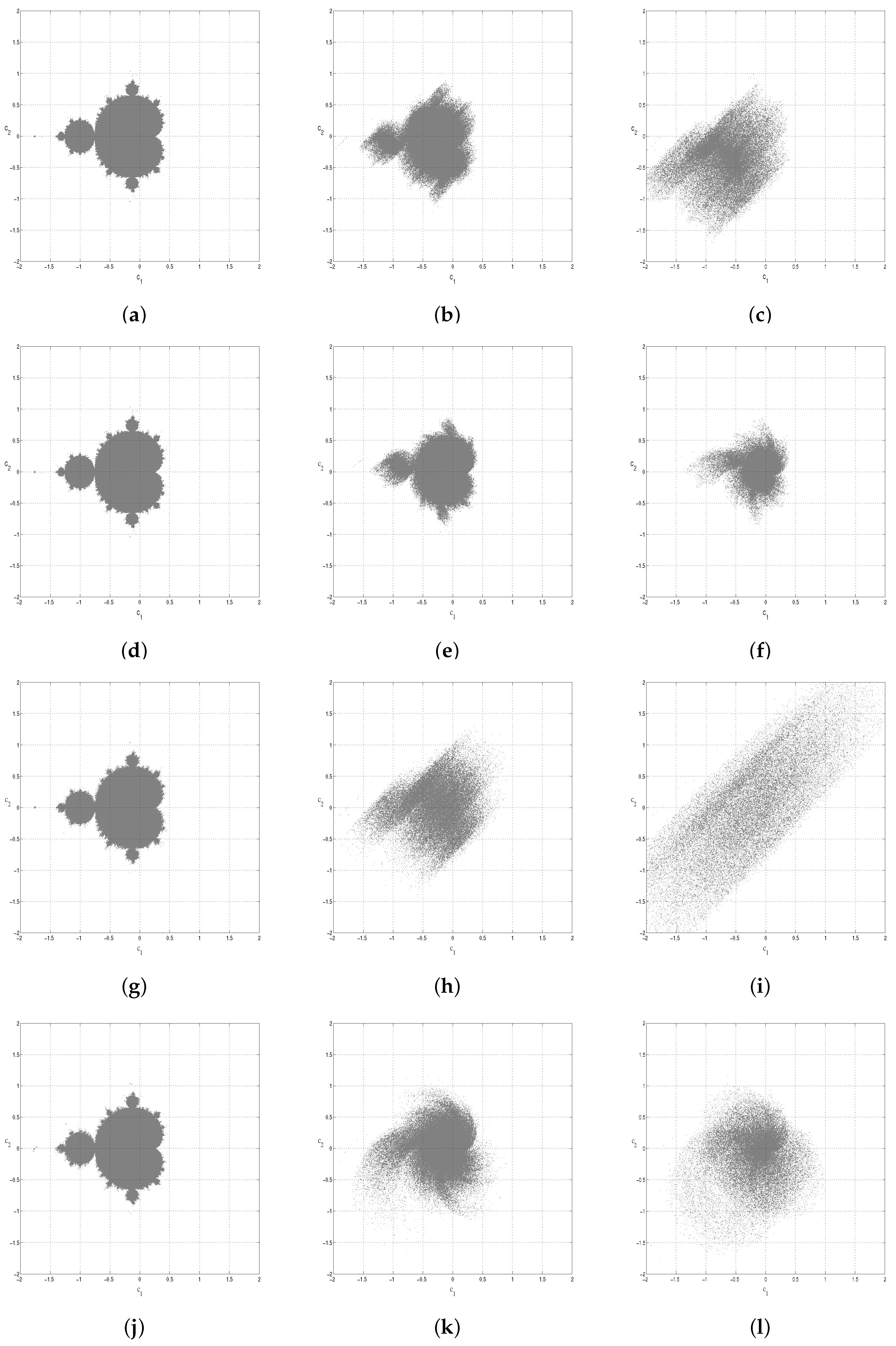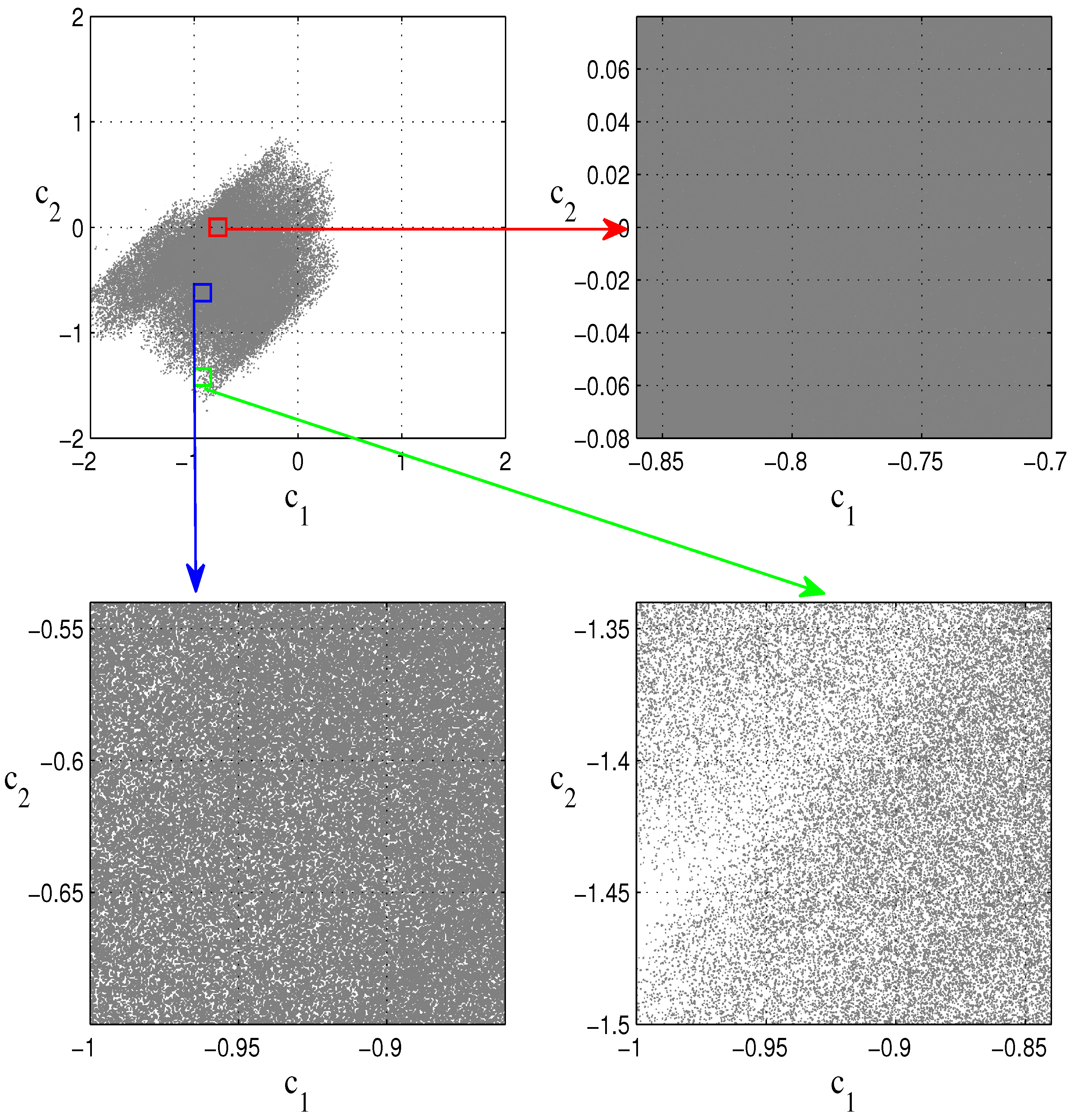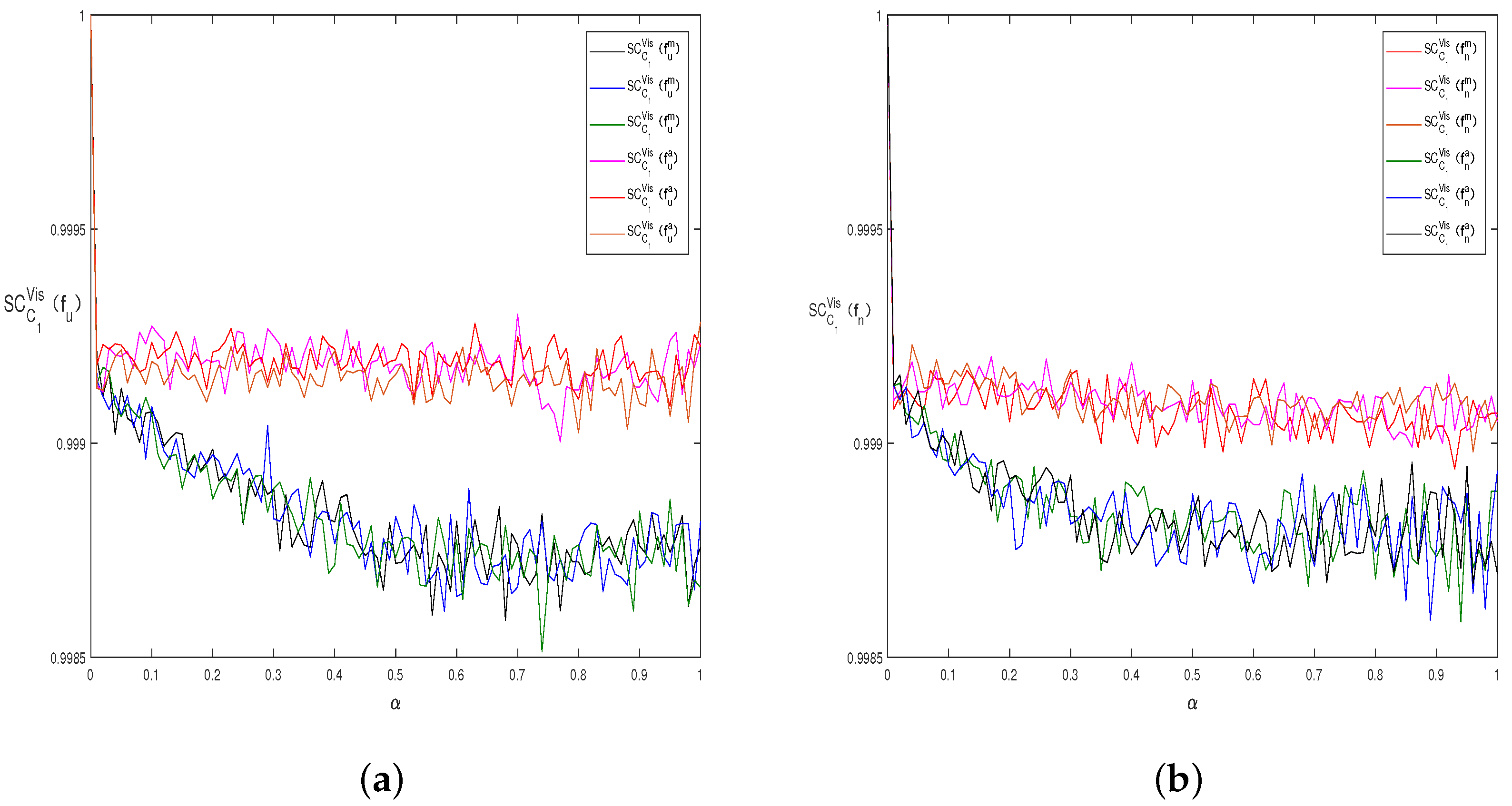The Symmetry in the Noise-Perturbed Mandelbrot Set
Abstract
:1. Introduction
- (1)
- Application of the “symmetry criterion” method [30] to investigate the Mandelbrot set. To the best of our knowledge, the work in [30] was the first study that addressed the quantization of the symmetry destruction of the noise-perturbed Julia set. In this work, we applied it to the research of another fractal set, namely the Mandelbrot set.
- (2)
- The proposition of a new “visual symmetry criterion” method. It is noted that the current method’s principle of calculating the quantized ratio of the symmetric region to the whole M-set is not very effective for measuring some visually-asymmetric sets. Thus, by adding a weight to the “symmetry index”, we modified the method to a novel one named the “visual symmetry criterion” method, which is more in line with visual habits.
2. Preliminaries
3. Methods
3.1. The “Symmetry Criterion” Method
- (1)
- For both and , the symmetry of decreases significantly when , and it tends to be stable on the whole. This observation is in accordance with the conclusion for 3D Julia sets [30].
- (2)
- For both and , the symmetry of decreases with the increase in a, and it continues this trend on the whole.
- (3)
- For both and , it can be seen that is larger than with the same noise strength . This supports the conclusion in Figure 2.
- (4)
- Figure 4a,b seems to have roughly the same trend. That is, with the same noise strength, the noises and have the same quantized symmetry criterion. A small difference in the details is that the fluctuation of is bigger than that of when . The visual evidence of this fluctuation can be seen from Figure 2i, in which has almost lost its fractal structure.
- (5)
- Both and remain at a value close to one. That is, the visually-asymmetric noise-perturbed Mandelbrot set may have a high quantified symmetry index.
3.2. The Modified “Visual Symmetry Criterion” Method
4. Discussion
- (1)
- “Symmetry criterion”: The method [30] focuses on the essence of the symmetry distribution. It can be seen in Figure 5 that the region with the dense distribution has a greater effect on the results than the region with the sparse distribution. Thus, we can also title the method the “virtual symmetry criterion”. It can be applied to engineering problems that require high data accuracy.
- (2)
- “Visual symmetry criterion”: The method focuses more on the sense of vision. That is, the farther away from the symmetry axis, the greater the effect on the visual sense. Thus, the “visual symmetry criterion” can be applied to some pattern recognition fields that focus on the senses of human beings.
- (1)
- References [21,22,25,26,27,29] mainly discussed the deviation distance or the structural damages in noise-perturbed fractals sets. Some scholars have examined the symmetry property of noise-perturbed fractal sets [23,24,28], but quantitative investigations of symmetry in a noise-perturbed fractal set are limited to [30] and this work.
- (2)
- We introduce more types of noise, and , into such kinds of research.
- (3)
- A more effective method, the “visual symmetry criterion” method, for classifying the visually-asymmetric set is proposed in this work.
- (1)
- The underlying mathematical proof of the graphical and algorithm observations is difficult to provide. We intend to investigate this topic in future work.
- (2)
- The calculation quantity of the “visual symmetry criterion” is large because it needs to calculate a weight w for each step. Thus, it is hard to extend this method to the spatial case.
5. Conclusions
Author Contributions
Funding
Acknowledgments
Conflicts of Interest
References
- Julia, G. Mèmoire sur l’itèration des fonctions rationnelles. J. Math. Pures Appl. 1918, 8, 47–245. [Google Scholar]
- Mandelbrot, B.B. Fractals and Chaos: The Mandelbrot Set and Beyond; Springer Science & Business Media: New York, NY, USA, 2013; 320p, ISBN 0-387-20158-0. [Google Scholar]
- Lei, T. Similarity between the Mandelbrot set and Julia sets. Commun. Math. Phys. 1990, 134, 587–617. [Google Scholar] [CrossRef]
- Wang, X.Y. Fractal structures of the non-boundary region of the generalized Mandelbrot set. Prog. Nat. Sci. 2001, 11, 693–700. [Google Scholar]
- Liu, S.; Pan, Z.; Fu, W.; Cheng, X. Fractal generation method based on asymptote family of generalized Mandelbrot set and its application. J. Nonlinear Sci. Appl. 2017, 10, 1148–1161. [Google Scholar] [CrossRef]
- Wang, X.; Jin, T. Hyperdimensional generalized M-J sets in hypercomplex number space. Nonlinear Dyn. 2013, 73, 843–852. [Google Scholar] [CrossRef]
- Fisher, Y.; McGuire, M.; Voss, R.F.; Barnsley, M.F.; Devaney, R.L.; Mandelbrot, B.B. The Science of Fractal Images; Peitgen, H.O., Saupe, D., Eds.; Springer Publishing Company, Incorporated: Berlin, Germany, 2011. [Google Scholar]
- Zhang, Y.P.; Sun, W.H. Synchronization and coupling of Mandelbrot sets. Nonlinear Dyn. 2011, 64, 59–63. [Google Scholar] [CrossRef]
- Wang, D.; Liu, S.T.; Zhao, Y.; Jiang, C.M. Control of the spatial Mandelbrot set generated in coupled map lattice. Nonlinear Dyn. 2016, 84, 1795–1803. [Google Scholar] [CrossRef]
- Rani, M.; Kumar, V. Superior Mandelbrot set. J. Korea Soc. Math. Educ. Ser. D Res. Math. Educ. 2004, 8, 279–291. [Google Scholar]
- Rochon, D. A generalized Mandelbrot set for bicomplex numbers. Fractals 2010, 8, 355–368. [Google Scholar] [CrossRef]
- Beck, C. Physical meaning for Mandelbrot and Julia sets. Phys. Nonlinear Phenom. 1999, 125, 171–182. [Google Scholar] [CrossRef]
- Levin, M. Morphogenetic fields in embryogenesis, regeneration, and cancer: Non-local control of complex patterning. Biosystems 2012, 109, 243–261. [Google Scholar] [CrossRef] [PubMed]
- Sun, W.H.; Zhang, Y.P. Fractal analysis and control in the predator-prey model. Int. J. Comput. Math. 2017, 94, 737–746. [Google Scholar] [CrossRef]
- Sun, Y.; Xu, R.; Chen, L.; Xu, X. Image compression and encryption scheme using fractal dictionary and Julia set. Image Process. IET 2014, 9, 173–183. [Google Scholar] [CrossRef]
- Butusov, D.N.; Karimov, A.I.; Pyko, N.S.; Pyko, S.A.; Bogachev, M.I. Discrete chaotic maps obtained by symmetric integration. Phys. Stat. Mech. Its Appl. 2018, 509, 955–970. [Google Scholar] [CrossRef]
- Butusov, D.N.; Karimov, A.I.; Tutueva, A.V. Symmetric extrapolation solvers for ordinary differential equations. In Proceedings of the 2016 IEEE NW Russia Young Researchers in Electrical and Electronic Engineering Conference, St. Petersburg, Russia, 2–3 February 2016; pp. 162–167. [Google Scholar]
- Li, C.; Hu, W.; Sprott, J.C.; Wang, X. Multistability in symmetric chaotic systems. Eur. Phys. J. Spec. Top. 2015, 224, 1493–1506. [Google Scholar] [CrossRef]
- Bandt, C. On the Mandelbrot set for pairs of linear maps. Nonlinearity 2002, 15, 11–27. [Google Scholar] [CrossRef]
- Wang, D.; Liu, S.T. On the boundedness and symmetry properties of the fractal sets generated from alternated complex map. Symmetry 2016, 8, 7. [Google Scholar] [CrossRef]
- Argyris, J.; Karakasidis, T.E.; Andreadis, I. On the Julia set of the perturbed Mandelbrot map. Chaos Solitons Fractals 2000, 11, 2067–2073. [Google Scholar] [CrossRef]
- Argyris, J.; Karakasidis, T.E.; Andreadis, I. On the Julia sets of a noise-perturbed Mandelbrot map. Chaos Solitons Fractals 2002, 13, 245–252. [Google Scholar] [CrossRef]
- Argyris, J.; Andreadis, I.; Karakasidis, T.E. On perturbations of the Mandelbrot map. Chaos Solitons Fractals 2000, 11, 1131–1136. [Google Scholar] [CrossRef]
- Wang, X.Y.; Wang, Z.; Lang, Y.; Zhang, Z.F. Noise perturbed generalized Mandelbrot sets. J. Math. Anal. Appl. 2008, 347, 179–187. [Google Scholar] [CrossRef]
- Wang, X.Y.; Jia, R.H.; Zhang, Z.F. The generalized Mandelbrot set perturbed by composing noise of additive and multiplicative. Appl. Math. Comput. 2009, 210, 107–118. [Google Scholar]
- Rani, M.; Agarwal, R. Effect of stochastic noise on superior Julia sets. J. Math. Imaging Vis. 2010, 36, 63. [Google Scholar] [CrossRef]
- Agarwal, R.; Agawal, V. Dynamic noise perturbed generalized superior Mandelbrot sets. Nonlinear Dyn. 2012, 67, 1883–1891. [Google Scholar] [CrossRef]
- Andreadis, I.; Karakasidis, T.E. On a topological closeness of perturbed Mandelbrot sets. Appl. Math. Comput. 2010, 215, 3674–3683. [Google Scholar] [CrossRef]
- Andreadis, I.; Karakasidis, T.E. On a closeness of the Julia sets of noise-perturbed complex quadratic maps. Int. J. Bifurc. Chaos 2012, 22, 1250221. [Google Scholar] [CrossRef]
- Wang, D.; Liu, X.Y. On the noise-perturbed spatial Julia set generated by Lorenz system. Commun. Nonlinear Sci. Numer. Simul. 2017, 50, 229–240. [Google Scholar] [CrossRef]
- Rădulescu, A.; Pignatelli, A. Real and complex behavior for networks of coupled logistic maps. Nonlinear Dyn. 2017, 87, 1295–1313. [Google Scholar]
- Rădulescu, A.; Evans, S. Asymptotic sets in networks of coupled quadratic nodes. J. Complex Netw. 2018. [Google Scholar] [CrossRef]






© 2019 by the authors. Licensee MDPI, Basel, Switzerland. This article is an open access article distributed under the terms and conditions of the Creative Commons Attribution (CC BY) license (http://creativecommons.org/licenses/by/4.0/).
Share and Cite
Sun, T.; Wang, D. The Symmetry in the Noise-Perturbed Mandelbrot Set. Symmetry 2019, 11, 577. https://doi.org/10.3390/sym11040577
Sun T, Wang D. The Symmetry in the Noise-Perturbed Mandelbrot Set. Symmetry. 2019; 11(4):577. https://doi.org/10.3390/sym11040577
Chicago/Turabian StyleSun, Tianwen, and Da Wang. 2019. "The Symmetry in the Noise-Perturbed Mandelbrot Set" Symmetry 11, no. 4: 577. https://doi.org/10.3390/sym11040577
APA StyleSun, T., & Wang, D. (2019). The Symmetry in the Noise-Perturbed Mandelbrot Set. Symmetry, 11(4), 577. https://doi.org/10.3390/sym11040577




